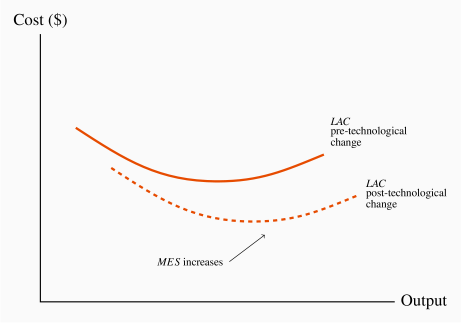Technological change represents innovation that can reduce the cost of production or bring new products on line. As stated earlier, the very long run is a period that is sufficiently long for new technology to evolve and be implemented.
Technological change represents innovation that can reduce the cost of production or bring new products on line.
Technological change has had an enormous impact on economic life for several centuries. It is not something that is defined in terms of the recent telecommunications revolution. The industrial revolution began in eighteenth century Britain. It was accompanied by a less well-recognized, but equally important, agricultural revolution. The improvement in cultivation technology, and ensuing higher yields, freed up enough labour to populate the factories that were the core of the industrial revolution. The development and spread of mechanical power dominated the nineteenth century, and the mass production line of Henry Ford in autos or Andrew Carnegie in steel heralded in the twentieth century.
Globalization
The modern communications revolution has reduced costs, just like its predecessors. But it has also greatly sped up globalization, the increasing integration of national markets.
Globalization is the tendency for international markets to be ever more integrated.
Globalization has several drivers: lower transportation and communication costs; reduced barriers to trade and capital mobility; the spread of new technologies that facilitate cost and quality control; different wage rates between developed and less developed economies. New technology and better communications have been critical in both increasing the minimum efficient scale of operation and reducing diseconomies of scale; they facilitate the efficient management of large companies.
The continued reduction in trade barriers in the post-World War II era has also meant that the effective marketplace has become the globe rather than the national economy for many products. Companies like Apple, Microsoft, and Facebook are visible worldwide. Globalization has been accompanied by the collapse of the Soviet Union, the adoption of an outward looking philosophy on the part of China, and an increasing role for the market place in India. These developments together have facilitated the outsourcing of much of the West's manufacturing to lower-wage economies.
But new technology not only helps existing companies grow large; it also enables new ones to start up. It is now cheaper for small producers to manage their inventories and maintain contact with their own suppliers.
The impact of technology is to reduce the cost of production, hence it will lower the average cost curve in both the short and long run. First, decreasing returns to scale become less probable due to improved communications, so the upward sloping section of the LRAC curve may disappear altogether. Second, capital costs are now lower than in earlier times, because much modern technology has transformed some fixed costs into variable cost: Both software and hardware functions can be subcontracted to specialty firms, who in turn may use cloud computing services, and it is thus no longer necessary to have a substantial in-house computing department. The use of almost-free software such as Skype, Hangouts and WhatsApp reduces communication costs. Advertising on social media is more effective and less costly than in traditional hard-print form. Hiring may be cheaper through LinkedIn than through a traditional human resources department. These developments may actually reduce the minimum efficient scale of operation because they reduce the need for large outlays on fixed capital. On the other hand, changes in technology may induce producers to use more capital and less labor, with the passage of time. That would increase the minimum efficient scale. An example of this phenomenon is in mining, or tunnel drilling, where capital investment per worker is greater than when technology was less developed. A further example is the introduction of robotic assistants in Amazon warehouses. In these scenarios the minimum efficient scale should increase, and that is illustrated in Figure 8.7.
The local diffusion of technology
The impacts of technological change are not just evident in a global context. Technological change impacts every sector of the domestic economy. For example, the modern era in dentistry sees specialists in root canals (endodentists) performing root canals in the space of a single hour with the help of new technology; dental implants into bone, as an alternative to dentures, are commonplace; crowns can be machined with little human intervention; and X-rays are now performed with about one hundredth of the power formerly required. These technologies spread and are adopted through several channels. Dental practices do not usually compete on the basis of price, but if they do not adopt best practices and new technologies, then community word of mouth will see patients shifting to more efficient operators.
Some technological developments are protected by patents. But patent protection rarely inhibits new and more efficient practices that in some way mimic patent breakthroughs.



